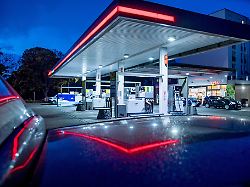ADAC expects relaxation in 2024
The second most expensive fuel year of all time is coming to an end
December 26, 2023, 7:01 a.m
Listen to article
This audio version was artificially generated. More info | Send feedback
“2023 was not as extreme as 2022, but still an extraordinary year,” says the ADAC about the balance of fuel prices. On average, drivers still paid significantly more than before the Ukraine war. Nevertheless, the automobile club is optimistic about 2024.
While the second most expensive year for fuel prices in Germany is coming to an end, the recent fall in prices gives drivers hope that 2024 will be more relaxed at the pump. “For 2024, I am cautiously optimistic that gasoline will be at around the current, somewhat more relaxed level,” says ADAC fuel market expert Christian Laberer. “Diesel could even give way if the decline typical for this time of year comes in the spring with the end of the heating season.” Overall, however, it depends heavily on the price of oil, which can rise sharply in the event of a global crisis, he adds.
“2023 was not as extreme as 2022, but still an extraordinary year – and the second most expensive year of all time,” says Laberer. This is already clear a few days before the end of the year. As long as there are no massive rises or falls in fuel prices in the double-digit cent range, diesel will have cost an annual average of around 1.72 euros per liter, and premium grade E10 petrol will have cost 1.79 euros. Compared to the extreme year of 2022, E10 was around 7 cents cheaper, diesel by more than 22 cents.
These averages hide strong fluctuations. Between the cheapest and the most expensive day there were around 21 cents for E10, and even a good 30 cents for diesel. This is mainly due to two opposing developments on the crude oil markets: shortages on the supply side and weakness on the demand side. On the one hand, there was a resurgence of the OPEC+ association of around 20 countries, which significantly cut its oil production and thus drove the price up to almost $100 per barrel (159 liters).
But as the economy weakened, demand also weakened, which depressed the price of oil again. There were also crises such as the Gaza war after the Hamas massacre in Israel on October 7th or attacks by the Iran-backed Houthi rebels on ships in the Red Sea. As a result, prices fluctuated greatly, but at the end of the year they were back where they were at the beginning of the year – around 80 US dollars.
ADAC advises: fill up early before the New Year
Experts expect crude oil prices to tend to rise in the coming year. The raw materials experts at Commerzbank expect that large demand regions such as the USA and Europe will likely experience economic weakness. However, growth is likely to pick up by the second half of the year at the latest, including in China. Then raw material prices should go up again. The economists at BayernLB expect prices towards 90 US dollars.
The fact that ADAC expert Laberer still has hope for stable or even falling prices at the gas station is not only due to the seasonal effect on diesel, but also because he still sees some room in the prices. In addition, a development of the past few months could continue: “Since late summer, the previously very high margins of the refineries have been declining. This also had a positive effect on the price at the pump,” he says. “It remains to be hoped that this will continue. The Cartel Office’s close look at the ongoing sector investigation into refineries and fuel wholesale could also help here.”
At the turn of the year, however, a small price jump can initially be expected if the CO2 price rises. According to Laberer, this means an additional burden of around 4.3 cents per liter for E10 and 4.7 cents per liter for diesel. “But it may be that the oil companies at least partially anticipate this price increase a few days before the New Year,” he says and advises it’s better to fill up earlier.
A rough calculation by the ADAC shows how much fuel prices mean for consumers. The driver of a diesel engine with typical consumption and typical mileage saved around 300 euros in 2023 compared to 2022, and a typical driver of a car with a gasoline engine saved almost 60 euros. However, if you don’t use the extreme year 2022 as a comparison, but rather 2021, for example – a rather expensive year compared to long-term comparisons – things look different: the diesel driver then paid more than 400 euros in 2023, the owner of the petrol car a good 200 euros.
